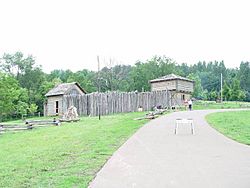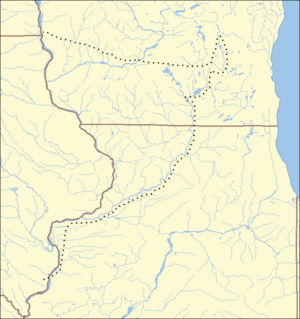Battle of Apple River Fort facts for kids
Quick facts for kids Battle of Apple River Fort |
|||||||
|---|---|---|---|---|---|---|---|
| Part of the Black Hawk War | |||||||
 Reconstructed Apple River Fort, near its original site |
|||||||
|
|||||||
| Belligerents | |||||||
| Sauk/Meskwaki | |||||||
| Commanders and leaders | |||||||
| Captain Clack Stone/Illinois Militia | Black Hawk | ||||||
| Strength | |||||||
| 28-30 | 150-200 | ||||||
| Casualties and losses | |||||||
| 1 KIA 2 WIA |
Unknown | ||||||
The Battle of Apple River Fort was an important event during the Black Hawk War on June 24, 1832. It happened near what is now Elizabeth, Illinois. In this battle, a group of about 200 Sauk and Meskwaki warriors, led by Chief Black Hawk, attacked the Apple River Fort.
The attack began when four messengers from Galena, Illinois accidentally came across Black Hawk's group. One messenger was hurt, but they quickly rode to warn the 70 settlers inside the fort. This warning saved many lives. About 28-30 men and boys, led by Captain Clack Stone, defended the fort. They fought bravely against Black Hawk's larger group for about an hour.
The strong defense made Black Hawk realize that attacking the fort directly would be too difficult. Instead, his warriors raided nearby cabins for food and supplies. As night fell, Black Hawk and his group left the area.
After the battle, some people inside the fort were praised for their courage. Elizabeth Armstrong was one of them. She helped organize the women and children. They made rifle balls and prepared gunpowder cartridges, which helped the defenders keep firing their weapons. Sadly, one messenger, George Harkleroad, was fatally wounded. The number of warriors hurt is not known.
The original fort was later taken apart, and its wood was used for other buildings. Today, a replica of the fort stands near the original spot in Elizabeth, Illinois. It is now a historic site managed by the Illinois Department of Natural Resources.
Why the Battle Happened: The Black Hawk War
The Battle of Apple River Fort was part of a larger conflict called the Black Hawk War. This war started because of disagreements over land.
Land Disputes and the 1804 Treaty
In 1804, a treaty was signed between William H. Harrison, who was the Governor of Indiana Territory, and some Sauk and Meskwaki leaders. This treaty said that the Sauk and Meskwaki tribes would move out of their lands in Illinois and go west of the Mississippi River. They moved in 1828.
However, a respected Sauk warrior named Black Hawk and others did not agree with this treaty. They believed that the full tribal councils were not asked, and the leaders who signed it did not have the power to give away their lands.
Black Hawk's Return to Illinois
Black Hawk was upset about losing his homeland. Between 1830 and 1831, he led his people back across the Mississippi River into Illinois several times. Each time, he was convinced to return without any fighting.
In April 1832, Black Hawk gathered about 500 warriors and their families. He hoped to find allies among other tribes and get supplies from the British in Canada. He moved his group, known as the "British Band," into Illinois again.
The Start of the Black Hawk War
Black Hawk did not find the allies he hoped for. When he tried to return to Iowa, he was stopped by soldiers. A fight, known as the Battle of Stillman's Run, happened where the soldiers fled. After this, more battles followed. Soldiers from Michigan Territory and Illinois were called to find Black Hawk's group. This conflict became known as the Black Hawk War.
Events Leading to Apple River Fort
Many events happened between the Battle of Stillman's Run and the Battle of Apple River Fort. There were attacks at places like Buffalo Grove and the Plum River settlement. One sad event was the Indian Creek massacre. These events took place from mid-May to late June 1832.
Just before the Battle of Apple River Fort, two smaller but important fights happened between June 16 and 18. These battles, known as "Stephenson's Fight" (now sometimes called Waddams Grove) and the one at Horseshoe Bend in Wisconsin, helped change how people viewed the soldiers after their earlier defeat.
Map of Black Hawk War sites
Preparing for Conflict: The Apple River Fort
After the soldiers' defeat at Stillman's Run on May 14, many settlers in the Galena area became very scared. Many people left their homes. Rumors spread that many warriors were attacking all over Northern Illinois, causing great fear.
At the Apple River Settlement, people decided to form their own group of soldiers, called a militia. This group had 46 men. Captain Clack Stone was chosen to lead them.
Building the Fort
The settlers quickly built a strong blockhouse at Apple River Fort around May 22. Later, they added a stockade, which is a fence made of tall, strong posts. Just before June 18, 1832, horses were stolen from the fort. This event was one of several that led to a small fight known as "Stephenson's Fight."
The Day of the Battle
On June 24, 1832, a wagon carrying meat and lead arrived at Apple River Fort around noon. At the same time, Black Hawk and his 200 warriors were also heading towards the fort. They gathered secretly at a place called Terrapin Ridge.
Around 4 p.m., four messengers from Galena arrived at the fort. They were on their way to an army camp. The people at the fort were excited to hear news about the conflict with Black Hawk.
Who Was at the Fort?
When the attack began, there were about 28-30 armed militia members inside Apple River Fort. About 40 women, children, and other settlers were also there. Captain Clack Stone and his officers led the defense. Most of the defenders were part of Stone's militia, along with a few other civilians. Some militia members were away from the fort and missed the battle.
The Battle Unfolds
Messengers Under Attack
Four messengers from Galena—George Harkleroad, Fred Dixon, Edmund Welch, and J. Kirkpatrick—were traveling to Dixon. They stopped at Apple River Fort for a quick meal. As they continued their journey, about 550 meters (600 yards) east of the fort, Black Hawk's advance group of about 30 warriors ambushed them.
Edmund Welch, the only one with a loaded gun, was shot in the hip and fell from his horse. His friends quickly aimed their unloaded weapons at the attackers to protect him. They managed to get Welch back and headed towards the fort. Fred Dixon bravely stayed behind to cover their retreat.
Three messengers reached the safety of the fort. Fred Dixon rode towards the Apple River but found a farm already taken over by Native Americans. He left his horse, crossed the river, and made his way to Galena to report the attack on Apple River Fort.
Fierce Fighting at the Fort
Inside the fort, settlers quickly took shelter. The men and boys prepared their weapons at the portholes (small openings for shooting). A fierce firefight began, with about 150 of Black Hawk's warriors attacking. The battle lasted for about an hour, with heavy gunfire from both sides.
At first, many women were hiding in the cabins. But several married women, including Elizabeth Armstrong, bravely rallied the other women and older children. They helped the soldiers by cutting and rolling gunpowder cartridges and molding rifle balls. The married women reloaded weapons, helping the soldiers keep up a fast rate of fire.
Black Hawk's Retreat
The intense fighting convinced Black Hawk that Apple River Fort was too strong to attack directly. He thought about burning the fort but worried that the smoke would alert other soldiers nearby.
His warriors then slowed their attack and raided cabins near the fort. They took meat, flour, clothing, and cooking tools. They also raided the livestock. As darkness fell, Black Hawk quietly led his warriors away from the fort and retreated.
Casualties of the Battle
Despite the intense fighting, there were few casualties. Messenger George Harkleroad was shot early in the battle and sadly died. Another defender, Josiah Nutting, received a minor head wound. The number of Sauk warriors hurt is not known.
Aftermath of the Battle
Waiting for Reinforcements
The defenders at Apple River Fort stayed in their positions all night, expecting another attack from Black Hawk. However, dawn arrived without any further incidents.
The next day, June 25, two companies of mounted rangers arrived at the fort from Galena, bringing relief. On the same day, Black Hawk's warriors encountered Major John Dement and his soldiers at the Second Battle of Kellogg's Grove. George Harkleroad, the only person who died at Apple River Fort, was buried near the fort, but his grave is no longer visible today.
A Heroine's Courage
Elizabeth Armstrong was praised as a heroine for her actions during the battle. She showed great courage under fire, which was something the soldiers had sometimes lacked earlier in the Black Hawk War. Her efforts helped make Black Hawk believe the fort was much more heavily defended than it actually was.
Some early writers mistakenly identified her as "Mrs. Graham."
The Fort Today
The original fort was taken down around 1847, and its wood was used to build a barn. Today, a replica of the fort and its three buildings has been reconstructed by the Apple River Fort Historic Foundation. The Apple River Fort Site is recognized on the U.S. National Register of Historic Places for its military and archaeological importance.
On January 1, 2001, the state of Illinois took over the operation of the reconstructed Apple River Fort and its visitor center. The state now manages the area as the Apple River Fort State Historic Site. Illinois' purchase was partly funded by a US$160,000 grant from the state.


